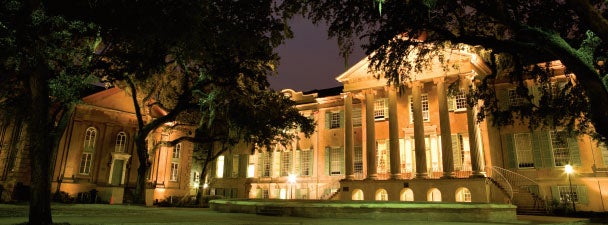
For more than 200 years, life at the College has been centered at its Cistern Yard. Here, in a sacred spot both at the heart of campus and downtown Charleston, magnificent buildings surround an incredible urban garden of live oaks and a large lawn. This is where generations of students have come to sit, paint, converse and study. This is where countless visitors have snapped pictures and thousands of graduates have skipped over a stage, donned in white dresses and white dinner jackets, their hands eagerly outstretched to accept hard-earned degrees.
This past May, more than 1,600 students and their families crowded the yard for the spring commencement ceremony. While the graduates’ achievements made the day significant enough, the audience was also able to take special delight in their surroundings. The College had just finished a nearly four-year project to restore and preserve the buildings of the Cistern Yard – and Randolph Hall, Towell Library and Porters Lodge have never looked better.

It’s perhaps most accurate to describe the painstaking work on these landmark buildings as artistry, plain and simple. Tradesmen were challenged to make repairs to the buildings while preserving the weathered patina on each façade. In areas where new stucco was applied over brick walls, workers scored the patches by hand and carefully painted the area with varying shades of lime wash to achieve a seamless blend.
Each and every door, window and shutter on the buildings was removed, restored and re-installed. Additionally, each light, or pane, of glass was removed from the windows to enable wood repairs. On Randolph Hall alone this meant the removal of more than 120 windows. Some of these windows had accumulated more than 35 layers of paint and featured sashes of 25 panes over 25 panes.
Other important work on Randolph Hall included the repair and partial replacement of the building’s terra-cotta capitals. Shipped down from Massachusetts in the 1850s when Charleston architect Edward Brickell White designed a southern portico for Randolph Hall (known as Main Building then), the capitals are some of the earliest pieces of architectural terra cotta in the country.
Repairs were also made to Randolph Hall’s slate roof, as well as to the slate roofs above Towell Library and Porters Lodge. New copper gutters and downspouts were installed on all three buildings, and deteriorated brownstone was replaced and repaired as needed. All three buildings also received new tension rods, otherwise known as earthquake bolts, to provide enhanced structural support.
These repairs and more were accomplished using a $3.7 million appropriation from the State. This money, in addition to resources from the College, was also used to improve the landscaping within the College’s historic campus, which was designated a National Historic Landmark in 1971. A new lawn and plantings, dramatic nighttime lighting and improved irrigation systems and walkways now complement the showcase buildings. The upkeep and maintenance of these buildings, as well as the scores not listed on the National Register but of historical significance, is one of the top priorities for the College.

“The College of Charleston has 80 buildings over 100 years old and several that are over 200 years old. They have stood the test of time through natural disasters, wars and economic turmoil,” says President P. George Benson. “These buildings truly represent the rich and interwoven histories of the College and the City of Charleston. And as the city’s largest historic preservationist, we take very seriously our obligation to preserve and protect them.
“Restoring these national treasures,” President Benson adds, “ensures that they will be enjoyed by students, faculty, staff and visitors for generations to come.”




